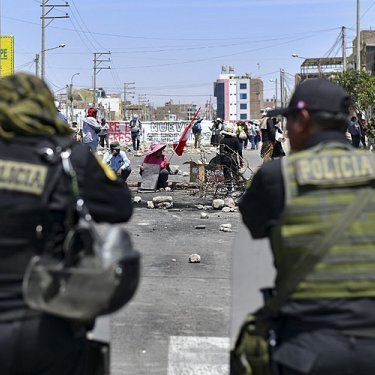Peru’s government must prevent violence against reporters covering crisis, says RSF

The Peruvian authorities are obstructing coverage of demonstrations calling for President Dina Boluarte’s resignation, says Reporters Without Borders (RSF). Since the protests began a few days after Pedro Castillo’s removal as president on 7 December, 29 journalists have been attacked, 11 of them by the police, according to RSF’s tally.
The protests peaked on 19 January, when tens of thousands of Castillo supporters demonstrated in the capital, Lima, after arriving in the city from the Andes in the preceding days. At least 44 civilians have been killed and hundreds have been wounded in clashes with the security forces since the protests began.
Of the 29 journalists who have been the victims of violence while covering the clashes between police and protesters in Lima and the south of the country, at least 11 have identified their attackers as police.
They include Aldair Mejía, a photographer working for the Spanish news agency EFE, who was shot in the leg in Juliaca, a city on the border with Bolivia, on 7 January. He told RSF that, a few hours before he was shot, a policeman threatened him for taking photos of a protester’s arrest.
They also include Alejandra Elías, a photographer working for the Associated Press agency, who was attacked by police officers near Cusco airport on 19 January. They threatened her when she photographed them attacking a passer-by. The police have not responded to requests from journalists since the first deaths in their heavy-handed crackdown.
“Since the removal Pedro Castillo, Peru’s fifth president since 2016, the country has been plunged into a political crisis with a steadily worsening human toll.”
“In most cases, journalists report that police officers deliberately covered the lenses of their cameras, tried to destroy their equipment or told them to leave the scene, clearly showing a desire to prevent coverage of their suppression of the demonstrations. The state of emergency must not be interpreted as a carte blanche for the police. President Boluarte’s government must not let the police stop reporters from covering the clashes, and it must guarantee their safety.”
The strongest challenge to Castillo’s removal and replacement by Peru’s traditional elite is coming from the southern Andes, where Castillo is from and where the most violence, including violence against journalists, has taken place. Conservative media outlets, which have taken to carrying disinformation in recent years, have been relaying the government’s version of events, which blames illegally funded terrorists and ignores the police violence.
Such irresponsible reporting by certain media outlets is putting media personnel in danger because it feeds protester hostility towards them, as was seen in particular in the violent attacks against reporters in Lima on 19 January. In a statement, the Peru Journalists’ Association accused the police of blocking reporters’ passage at a moment of confrontation with protesters.
Peru is ranked 77th out of 180 countries in RSF's 2022 World Press Freedom Index.
